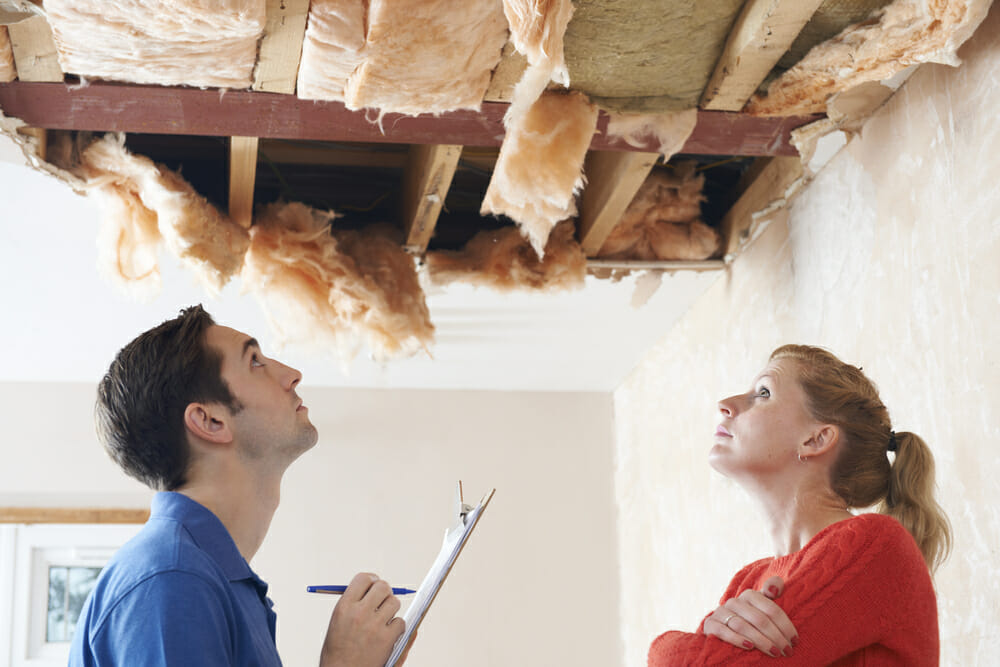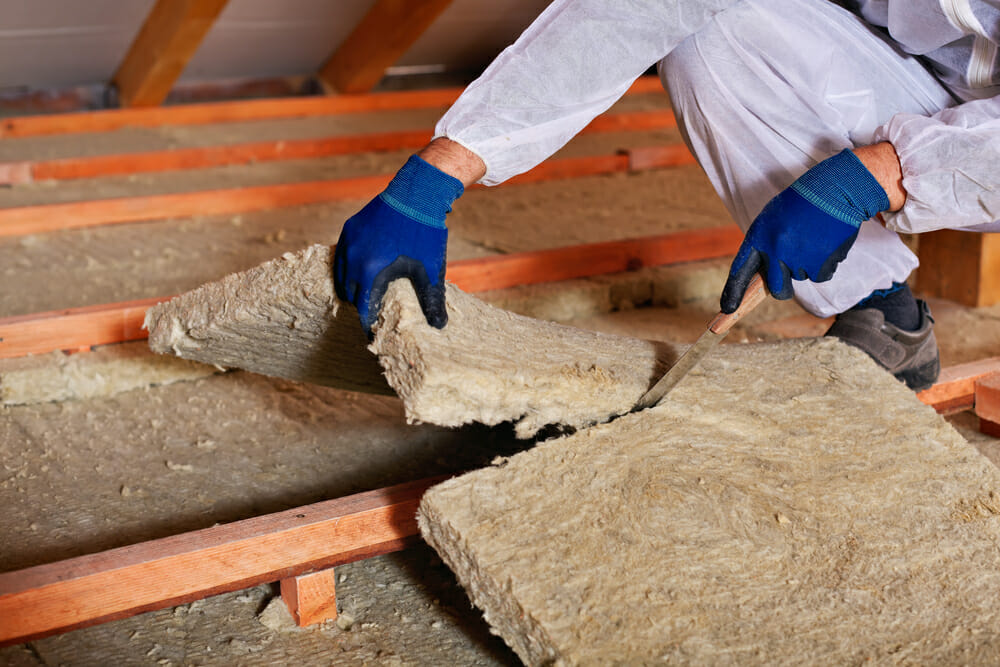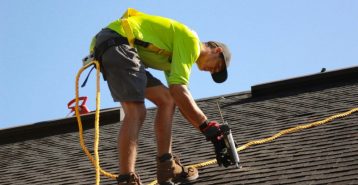Are you doing a roofing project?
Modernize can pair you with three to four pros in your area, so you can compare options and save time and money.
- Do Roofers Remove Insulation? A Homeowner’s Guide
- What Exactly Do Roofers Replace?
- Do You Need to Remove Old Insulation Before a Roof Replacement?
- Do Roofers Install Insulation?
- Should You Replace Insulation When Replacing a Roof?
- What If Your Roof Has Insulation Damage?
- The Best Time for Roof Insulation
- Key Takeaways
Do Roofers Remove Insulation? A Homeowner’s Guide
If you’re planning a roof replacement, you may be wondering whether you need to remove old insulation or if roofers handle it as part of the job. Roof insulation plays a big role in keeping your home energy-efficient, so it’s natural to ask whether it should be repaired, replaced, or left untouched when new shingles go on. In this guide, we’ll answer common questions homeowners have about insulation and roofing projects, including when roofers remove insulation, whether they install new insulation, and if you should consider replacing insulation during a roof replacement.
What Exactly Do Roofers Replace?
During a roof replacement, your roofer’s main focus is on the roof deck and shingles. Typically, the process includes tearing off old shingles, underlayment, and damaged decking boards, then installing new materials.
In most homes:
- Insulation Stays in Place: Attic or cavity insulation usually sits beneath the roof deck, so it’s not disturbed during shingle removal.
- Decking Is Left Intact Unless Damaged: If the decking is solid, roofers will not remove it or the insulation beneath it.
- Exceptions Occur With Damage or Special Assemblies: If leaks or rot have compromised the decking, some insulation may need to be replaced along with damaged boards.
Do You Need to Remove Old Insulation Before a Roof Replacement?
In most cases, you don’t need to remove old roof insulation before a reroof. The insulation is not part of the roofing system itself. It’s part of your attic or ceiling assembly.
The only time removal may be necessary is if:
- Leaks or Water Damage: When fiberglass batts or blown-in insulation become soaked, they lose their thermal resistance and can trap moisture. Wet insulation not only reduces efficiency but can also encourage mold growth, making replacement necessary.
- Insulation Above Decking: Some roof assemblies, such as flat, cathedral, or low-slope roofs, use rigid foam insulation installed above the decking. During a roof replacement, roofers may expose this insulation and determine whether it should be replaced.

Do Roofers Install Insulation?
Most roofing contractors don’t install attic insulation. Their primary expertise is shingles, underlayment, flashing, and decking. However, there are exceptions:
- Rigid Foam Insulation: Some roofers handle installing or replacing foam insulation panels above the decking, especially in flat or low-slope roof assemblies.
- Blown-In Insulation: In some cases, roofers will assist by opening a section of decking to allow blown-in insulation to be installed from above.
If you want attic insulation replaced or upgraded during a roof project, ask your contractor if they provide this service or coordinate with an insulation professional.
Find the Right Contractor for Your Roofing Project
Whether you’re ready to begin your project now or need some expert advice, our network of contractors are here to help. With a few simple questions, we’ll find the best local professionals for you
Should You Replace Insulation When Replacing a Roof?
While it isn’t always required, a roof replacement is a prime opportunity to upgrade insulation, especially if you’ve noticed drafts, high energy bills, or uneven temperatures.
Here are four reasons to consider replacing your home’s insulation during a roofing replacement:
- The insulation is water-damaged.
- Your attic feels drafty or under-insulated. Adding fiberglass batts or blown-in insulation can lower annual energy bills by up to $600, depending on the size of your home.
- You’re installing rigid foam above the deck. It’s easiest to add or replace these layers during a shingle tear-off.
- Your roof decking needs repair. If boards are removed, insulation may need to be replaced afterward.

What If Your Roof Has Insulation Damage?
When roofers tear off shingles, they may uncover hidden problems:
- Leaks: Long-term leaks can soak into insulation, reducing effectiveness and creating mold risk.
- Rotten Decking: If your boards are soft, spongy, or undersized (think older plywood), it’s probably time to replace them. However, this can disturb the insulation below.
- Mold Issues: Severe leaks can push mold into insulation and even walls. If so, look into mold remediation.
If your roofer finds these issues, they’ll likely recommend replacing damaged decking and insulation before installing new shingles.
The Best Time for Roof Insulation
Replacing your roof is a great time to assess the state of your home’s insulation because the deck is already exposed. This is especially true if you’ve been considering:
- Adding rigid foam insulation for energy efficiency.
- Replacing wet or moldy fiberglass batts.
- Boosting attic insulation to meet modern efficiency standards.
Key Takeaways
- Roofers don’t typically remove insulation unless it’s damaged or part of a roof assembly.
- Usually, roof contractors leave insulation alone. However, leaks or rot will necessitate a replacement.
- You’ll probably need to call an insulation specialist if you need a replacement. While some roofers will work on certain types of insulation, many don’t.
- Still, this is the perfect time to add insulation for better efficiency and comfort.
Bottom Line: You don’t need to remove insulation before a roofing project. You should, however, use the opportunity to check whether it’s time for an upgrade. If you’ve noticed leaks, drafts, or higher energy bills, ask your roofer about insulation options.
Find the Right Contractor for Your Roofing Project
Whether you’re ready to begin your project now or need some expert advice, our network of contractors are here to help. With a few simple questions, we’ll find the best local professionals for you
Reviews from Real Homeowners
Welcome to Homeowner Resources! We are the Modernize blog. Modernize pairs more than 3 million homeowners a year with pre-vetted contractors in their area. This blog started because we believe homeowners should know everything about their homes, from how their HVAC works to which front door colors they might love. On Homeowner Resources, you can find information on every part of your home, right down to how you can negotiate with contractors to get the best price. Here's more about the blog.
Need a contractor? Learn more about how Modernize finds the right pro for you.





